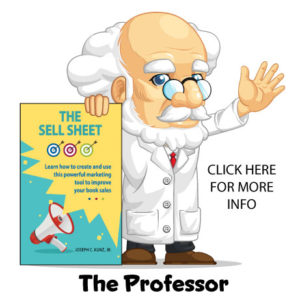Synopsis
This worksheet and questionnaire is simply a boiled-down list to help you start to organize what you’ll need to begin building your first sell sheet. Part I is very straightforward, and it’s just a matter of filling in the blanks with some specific facts about your book. But, in Part II, you’ll need to give some honest thought and reflection about yourself, your book, and your audience.
What You Will Learn
1. You will learn the essential elements that are required for an effective sell sheet.
2. You will learn how to analyze and explain what you book is truly about.
3. You will learn that this process will force you to look at your book in a new way.
Introduction
This worksheet and questionnaire is a really quick and easy way to help you start building your first sell sheet. Part I is very straightforward, and is just a matter of filling in the blanks.

But, in Part II, you will need to give some honest thought and reflection about yourself, your book, and your audience. Idealistically, the questions in this part should have been thought about and analyzed before and during the writing of your book.
But here you’ll need to force yourself to boil down your book’s mission, objective, and message into a few well thought out, and very tightly written paragraphs. (Honestly, just between you and me, this is the challenging fun part. So, fill up your coffee cup, pull up your socks, and get started.)
And, while you’re working on your sell sheet, you need to be looking at the sell sheets of other books, especially (1) those that are selling well on Amazon, and, (2) those that are on a similar subject as your book. Look at and analyze as many as possible.
Instructions:
Start building your book’s sell sheet by filling in this template. Some information in Part I might not apply to you, so leave those parts blank.
If you fill in the blanks in Part I, and then carefully and honestly answer the questions in Part II, you will be well on your way to creating a great sell sheet.

Part I: Sell Sheet Worksheet
Compile the following information:
1. Picture/image in jpg format of the front cover
2. Description of the book from back cover and introduction
3. Title of book
4. Subtitle
5. Author name
6. Co-author name
7. Author photograph in jpg format
8. Foreword author’s name
9. Publisher’s name and address
10. BISG category where your book can be found in the bookstore
11. ISBN 13 Bookland barcode with price barcode for at least one of the main formats
12. QR code for the book’s website, in jpg format
13. Format, such as pdf, paperback, hardcover, ebook
14. Publication date that your book will be available for sale
15. Pages: this can mean total page count between the covers, or from chapter 1 to the end of the last chapter
16. Cover price
17. Trim size, such as 5.5” x 8.5”; 6” x 9”
18. Available from which retailers, wholesalers, and distributors
19. Marketing plans that you have developed to market this book
20. Quotes/testimonials/blurbs
21. Call-to-action, such as “buy now on amazon”; or “visit my website for
more information”
Part II: Sell Sheet Questionnaire
Answer the following questions:
 1. What is your objective for this sell sheet?
1. What is your objective for this sell sheet?
2. What is your most important goal? Second most important? Third?
3. What information will help you achieve your objective? Start by listing everything you might want to include about your book.
4. Who is your audience for this sell sheet?
5. What can you say to grab the reader’s attention?
6. What benefit will your audience get from reading your book?
7. Why should someone buy your book over all of the others that are available?
8. What is your unique selling point? Why are you the one to be writing this book?
Why you?
9. What do you want your sell sheet reader to do?

Conclusion
Ok, you made it this far. Great. But, you are not done yet with your sell sheet – not by a long shot. You will be re-analyzing your sell sheet, and re-writing it, re-thinking about it, and improving it, many more times over the next few years. It’s a process. It’s simply part of the learning curve of self-publishing, book marketing, and running a business.
So, learn to enjoy it, and you and your book will keep making money for a long time to come. Whether it’s $25/month or $250/month, it’s money coming to you every month from something that you created and care for. A finely-tuned sell sheet is one of the things that will help you achieve this. (Now, go get another cup of coffee, and get started.)


